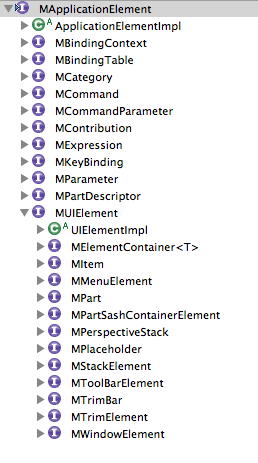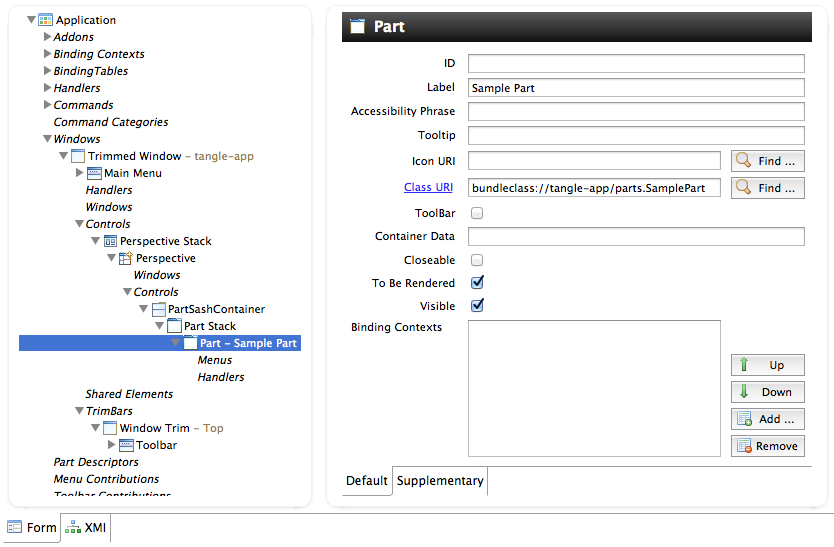[http://holbrook.github.io/2014/01/07/eclipse\_e4\_RCP\_quickstart.html](http://holbrook.github.io/2014/01/07/eclipse_e4_RCP_quickstart.html)
e4是位于底层的Equinox、EMF、SWT/JFace和上层的Eclipse应用(Plugin、RCP、RAP等)之间的一个应用开发平台。
从RCP的角度来说,e4的一个主要目标就是更轻松地编写和重用组件。
为了实现这个目标,与之前的Eclipse平台相比,e4带来的新特性主要包括:
* 基于EMF的应用模型(Application Model)
* 依赖注入
* 基于CSS定义外观
# [](http://holbrook.github.io/2014/01/07/eclipse_e4_RCP_quickstart.html#%E5%BF%AB%E9%80%9F%E5%BC%80%E5%A7%8B)快速开始
需要的环境和工具包括:
* Java >= 1.7
* Eclipse >= 4.3
* [Enide - Eclipse bootstrap e4](https://marketplace.eclipse.org/content/enide-eclipse-boostrap-e4)
* [WindowBuilder](http://www.eclipse.org/windowbuilder/)
安装了Eclipse bootstrap e4插件之后,可以创建Eclipse 4 --> Eclipse 4 Application Project。
生成的目录结构如下:
[](http://holbrook.github.io/2014/01/07/eclipse_e4_RCP_quickstart/e4_project.png)
其中,`*.product`文件是Eclipse插件项目的产品配置文件,可以以“E4Application”的方式运行:
[](http://holbrook.github.io/2014/01/07/eclipse_e4_RCP_quickstart/e4_product.png)
在`*.product`文件上右键–>Run As–>Eclipse Application,就可以启动一个e4应用:
[](http://holbrook.github.io/2014/01/07/eclipse_e4_RCP_quickstart/e4_application.png)
整个工程可以导出(Export)为"Eclipse Product",称为一个可以脱离Eclipse独立运行的、跨平台的RCP应用。
# [](http://holbrook.github.io/2014/01/07/eclipse_e4_RCP_quickstart.html#%E5%BA%94%E7%94%A8%E6%A8%A1%E5%9E%8B)应用模型
好吧,到目前为止,e4所表现出来的功能与Eclipse 3.x相比没什么区别。但是请关注一下上面生成的`Application.e4xmi`文件。
该文件是e4中的应用模型文件。
在 Eclipse 平台 UI 的早期版本中,workbench 被显式地硬编码来布局 workbench 窗口、workbench 页面、编辑器区域或视图堆栈。e4 引入了额外的一层,可将UI元素提取和抽象成一个模型。应用程序可以重新配置或扩展这个模型来制作不同的外观。这个模型也可被动态操纵;模型的改变可以立即反映出 UI 的变化。
e4的模型的特性为:
* 基于抽象描述
* 可以在运行时(runtime)更改
* 支持扩展
## [](http://holbrook.github.io/2014/01/07/eclipse_e4_RCP_quickstart.html#%E6%8A%BD%E8%B1%A1%E6%8F%8F%E8%BF%B0)抽象描述
e4的应用模型基于抽象描述——应用模型只定义了需要哪些组件,而不关注这些组件是如何实现的。e4应用模型实现了应用模型和实际视图(Views)的分离。
由于应用模型没有绑定的具体实现,这意味着一种可能:同一个应用模型可以用各种界面技术(如SWT/JFace, Swing甚至web,Flash)来实现。
模型中即描述了可视的组件,如 windows, parts (views 和 editors), menus, toolbars等,也可以描述非可视化组件如handlers, commands , key bindings等。所有能够在模型中描述的组件(包括可视化组件和非可视化组件),都实现了MApplicationElement接口,如下图:
[](http://holbrook.github.io/2014/01/07/eclipse_e4_RCP_quickstart/e4_MApplicationElement.png)
用Eclipse 4 model editor打开`Application.e4xmi`,可以看到如下的视图:
[](http://holbrook.github.io/2014/01/07/eclipse_e4_RCP_quickstart/e4_app_model.png)
`Application.e4xmi`是基于EMF定义的。其定义文件(.ecore)位于 org.eclipse.e4.ui.model.workbench 插件的model文件夹中。
## [](http://holbrook.github.io/2014/01/07/eclipse_e4_RCP_quickstart.html#%E5%B8%B8%E7%94%A8%E7%9A%84%E5%8F%AF%E8%A7%86%E5%8C%96%E7%BB%84%E4%BB%B6)常用的可视化组件
e4中的可视化组件描述类都来自`MUIElement`,该接口当然也继承了`MApplicationElement`接口。
常用的可视化组件包括:
* Window
窗口。一个Eclipse 应用可以包含一个或多个窗口。
[](http://holbrook.github.io/2014/01/07/eclipse_e4_RCP_quickstart/window.png)
* Parts
e4中不区分Views和editors,而是统一定义为Parts。Part能够放置在用户界面的任何位置,每个Part可以有自己的菜单、工具条,可以出来自己的模型数据。
[](http://holbrook.github.io/2014/01/07/eclipse_e4_RCP_quickstart/part.png)
* Perspective
Perspective是Parts的容器,可以管理内部Part的布局。一个应用可以有多个不同的Perspective(不能同时出现),以适应不同的应用场景。
比如,Eclipse IDE提供了Java、Java EE、Debug等Perspective。
在应用模型中,为了管理方便,还可以将Perspective放置到Perspective Stack中。
* PartStack 和 PartSashContainer
Part可以直接用于Window或Perspective中,也可以将其分组。使用PartStack 和 PartSashContainer可以实现Part的分组和布局管理。
PartStack可以容纳多个Part,每次只能显示其中一个Part,以页签(tab)的形式进行切换,而PartSashContainer以水平或竖直布局的方式同时显示多个Part。如下图:
[](http://holbrook.github.io/2014/01/07/eclipse_e4_RCP_quickstart/partstack.png)
通过PartStack和PartSashContainer的组合,能够创建出非常复杂的布局:
[](http://holbrook.github.io/2014/01/07/images/e4/elements/partsashcontainer.png)
PartStack 和 PartSashContainer中的子组件,可以设置“容器数据(Container Data)”,作为决定自己在容器中布局的参数。
[](http://holbrook.github.io/2014/01/07/images/e4/elements/containerdata.png)
需要注意的是,容器中的所有元素要么都设置容器数据,要么都不设置,否则会出现异常。
# [](http://holbrook.github.io/2014/01/07/eclipse_e4_RCP_quickstart.html#%E4%BE%9D%E8%B5%96%E6%B3%A8%E5%85%A5)依赖注入
基于上一节的内容,我们可以脱离UI组件的实现,直接定义出应用模型。
同样的,当我们实现一个UI组件的时候,也完全无需考虑应用模型的存在。在e4中,View甚至无需实现任何接口,而是通过依赖注入的方式获取UI组件的上下文环境。可以使用[JSR330](http://holbrook.github.io/2013/12/31/jsr330.html)中定义的`@Inject`注解,也可以使用e4的`org.eclipse.e4.ui.di`包中定义的`@Focus`、`@Persist`等注解。比如:
1
2
3
4
5
6
7
8
9
10
11
12
13
14
15
16
17
18
19
20
21
22
23
24
25
26
27
28
29
30
31
32
33
34
35
36
37
38
39
40
41
public class SamplePart {
private Text txtInput;
private TableViewer tableViewer;
@Inject
private MDirtyable dirty;
@PostConstruct
public void createComposite(Composite parent) {
parent.setLayout(new GridLayout(1, false));
txtInput = new Text(parent, SWT.BORDER);
txtInput.setMessage("Enter text to mark part as dirty");
txtInput.addModifyListener(new ModifyListener() {
@Override
public void modifyText(ModifyEvent e) {
dirty.setDirty(true);
}
});
txtInput.setLayoutData(new GridData(GridData.FILL_HORIZONTAL));
tableViewer = new TableViewer(parent);
tableViewer.add("Sample item 1");
tableViewer.add("Sample item 2");
tableViewer.add("Sample item 3");
tableViewer.add("Sample item 4");
tableViewer.add("Sample item 5");
tableViewer.getTable().setLayoutData(new GridData(GridData.FILL_BOTH));
}
@Focus
public void setFocus() {
tableViewer.getTable().setFocus();
}
@Persist
public void save() {
dirty.setDirty(false);
}
}
由于UI组件与应用模型完全解耦,可以对UI组件单独进行测试:
1
2
3
4
5
6
7
8
9
10
11
12
13
public static void main(String[] args) {
Display display = new Display();
Shell shell = new Shell(display);
shell.setLayout(new FillLayout());
SamplePart part = new SamplePart();
part.createComposite(shell);
shell.open();
while( !shell.isDisposed() ) {
if( ! display.readAndDispatch() ) {
display.sleep();
}
}
}
# [](http://holbrook.github.io/2014/01/07/eclipse_e4_RCP_quickstart.html#%E5%90%91%E6%A8%A1%E5%9E%8B%E6%B3%A8%E5%85%A5%E8%B5%84%E6%BA%90)向模型注入资源
前面两节分别介绍了创建应用模型和UI组件,接下来就是将二者结合起来。
在应用模型中,使用URI注入外部资源。比如,一个Part的Icon、Class都是通过URI注入的。这些资源是延迟加载(lazy loaded)的——只有显示某个可视化组件时,才加载其需要的资源。
模型使用的资源即可以在运行时注入或更改,也可以在Eclipse 4 model editor中指定初始的资源:
[](http://holbrook.github.io/2014/01/07/eclipse_e4_RCP_quickstart/e4_app_model.png)
任何形式的URI都可以作为资源使用。比如:`http://thinkinside.tk/assets/ico/favicon.png`。
对于Eclipse的插件环境,可以使用应用模型所在的插件(bundle)或来自其他插件的资源,分别使用
`bundleclass://Bundle-SymbolicName/ package.classname`和
`platform:/plugin/Bundle-SymbolicName/ path/filename.extension`的形式。
比如:
1
2
3
bundleclass://tangle-app/parts.SamplePart
platform:/plugin/test/icons/save_edit.gif
# 定义行为
e4的应用模型中,通过`Handler`定义行为。可视化组件和`Handler`之间通过`Command`关联。
与GUI组件一样,Handler的定义和实现也是分离的。在应用模型中定义的`Handler`通过Class URI关联到具体的实现类。我们可以单独编写一个`Handler`,无需实现任何接口:
```
public class MyHandler {
@Execute
public void execute(Shell shell) {
MessageDialog.openInformation(shell, "", "Hello World!");
}
@CanExecute
public boolean canExecute() {
return true;
}
}
```
其中,`canExecute()`方法是可选的。该方法定义了`execute()`方法是否可以被执行的一个开关。
由于`Handler`与应用模型完全解耦,可以单独对`Handler`进行测试:
```
public static void main(String[] args) {
Display display = new Display();
Shell shell = new Shell(display);
shell.open();
MyHandler.execute(shell);
while( !shell.isDisposed() ) {
if( ! display.readAndDispatch() ) {
display.sleep();
}
}
}
```
最简单的事件处理是菜单/工具条的处理。使用模型编辑器,可以在图形界面中很容易的将`Handler`和菜单项都关联到同一个`Commnad`,
即实现了行为的定义。这里不做截图,定义好的`Application.e4xmi`中相关内容可能是:
<!--定义一个Command-->
<commands xmi:id="_4mWoMHcyEeOYmvSF-9z33Q" elementId="holbrook.tangle.demo.myCommand" commandName="测试Cmd"/>
<!--定义一个Handler,并关联到Command-->
<handlers xmi:id="_J-fYsHczEeOYmvSF-9z33Q" elementId="holbrook.tangle.demo.myHandler" contributionURI="bundleclass://tangle-app/handlers.MyHandler" command="_4mWoMHcyEeOYmvSF-9z33Q"/>
<!--定义一个菜单项,也关联到Command-->
<mainMenu xmi:id="_FfY8UHbUEeOYmvSF-9z33Q" elementId="tangle-app.menu.0">
<children xsi:type="menu:Menu" xmi:id="_OwboQHc0EeOYmvSF-9z33Q" elementId="tangle-app.menu.1" label="测试菜单">
<children xsi:type="menu:HandledMenuItem" xmi:id="_TwOjEHc0EeOYmvSF-9z33Q" elementId="tangle-app.handledmenuitem.0" label="测试Cmd" command="_4mWoMHcyEeOYmvSF-9z33Q"/>
</children>
</mainMenu>
# CSS样式
e4将桌面应用和Web应用的一些特性融合在了一起,比如,可以通过CSS定义桌面应用的外观。
使用Eclipse bootstrap e4创建的Eclipse 4 Application Project,会包含一个`css/default.css`的空文件。
编辑这个文件就可以修改应用的外观。
在e4中,CSS选择器使用`type#id.class`的格式。其中:
* type:对应SWT组件类(如Button、Composite等)
* id:对应应用模型中的`elementId`
一些映射关系可以参考[这里](http://wiki.eclipse.org/E4/CSS/SWT_Mapping)
下面是一个CSS的例子:
```
Text {
font: Verdana 15px;
color: red;
background-color: green;
}
```
默认情况下,该CSS就会生效。因为在`plugin.xml`中,已经指定了CSS的扩展点:
更灵活的使用CSS是通过主题管理器。
- 前言
- CSS
- VUE
- Vue.js 安装
- Vue.js 目录结构
- Vue.js 起步
- Vue.js 模板语法
- Vue.js 条件与循环
- Vue.js 循环语句
- Vue.js 计算属性
- Vue.js 监听属性
- Vue.js 样式绑定
- Vue.js 事件处理器
- Vue.js 表单
- Vue.js 组件
- Vue.js 自定义指令
- Vue.js 路由
- React
- 安装
- React JSX
- React 组件
- 问题1
- React state
- React Props
- React 组件 API
- React 组件生命周期
- React AJAX
- React 表单与事件
- React Refs
- Babel
- Ant Design
- 安装
- 快速上手
- webpack
- 安装
- JavaScript
- 知识点
- 字符转数字
- js中字符串全部替换
- 函数
- reduce() 方法
- UI控件
- DataTable
- 语言配置 选项
- 增加行
- 列渲染-自定义列
- 创建行回调-操作行
- 自定义数据长度
- 默认设置
- 样式
- 集成Bootstrap 3
- 分页相关
- 数据
- NodeJs
- Electron
- 打包
- 介绍
- 知识点
- 使用 jquery
- CommonJS规范
- Bower
- 简介
- 安装
- Swing
- Swing界面组件
- JComboBox
- JDesktopPane和JInternalFrame
- JFrame
- JTabbedPane
- JTable
- JProgressBar
- JToolBar
- 知识点
- 截取log4j日志并输出到GUI组件
- JFrame 居中显示
- Swing中三种最大化初始窗口的方法
- Layout布局
- BorderLayout
- GridBagLayout
- GridLayout
- BoxLayout
- JxBrowser
- 浏览器引擎-Browser Engine
- 创建浏览器-Creating Browser
- 创建隐身浏览器-Creating Incognito Browser
- 存储用户数据-Storing User Data
- 处理浏览器-Disposing Browser
- 浏览器偏好-Browser Preferences
- 恢复浏览器-Restoring Browser
- 渲染流程事件-Render Process Events
- 渲染进程ID-Render Process ID
- 获取帧ID-Getting Frame IDs
- 获取产品版本-Getting Product Version
- 寻找文本-Finding Text
- 清除缓存-Clearing Cache
- 转发键盘事件-Forwarding Key Events
- 转发鼠标事件-Forwarding Mouse Events
- 加载内容-Loading Content
- 加载网址-Loading URL
- 使用POST加载URL-Loading URL with POST
- 加载HTML-Loading HTML
- 从JAR加载HTML-Loading HTML from JAR
- 获取HTML-Getting HTML
- 获取选定的HTML-Getting Selected HTML
- 加载事件-Loading Events
- 正在加载和等待-Loading & Waiting
- 显示PDF-Displaying PDF
- 网络活动-Network Events
- 处理资源加载-Handling Resources Loading
- 启用/禁用退格导航-Enabling/Disabling Backspace Navigation
- 处理SSL证书错误-Handling SSL Certificate Errors
- SSL证书验证程序-SSL Certificate Verifier
- 导航历史-Navigation History
- User-Agent
- WebSockets
- 处理加载-Handling Loading
- 修改POST / PUT / PATCH上传数据-Modifying POST/PUT/PATCH Upload Data
- HTML5本地和会话存储-HTML5 Local & Session storages
- 访问HTTP响应数据-Accessing HTTP response data
- HTTP服务器白名单-HTTP Server Whitelist
- 自定义协议处理程序-Custom Protocol Handler
- ActiveX
- 浏览器视图-Browser View
- 轻量级或重量级-Lightweight or Heavyweight
- 在Swing中使用JxBrowser-Using JxBrowser in Swing
- 在JavaFX中使用JxBrowser-Using JxBrowser in JavaFX
- 在SWT中使用JxBrowser-Using JxBrowser in SWT
- 自定义CSS光标-Custom CSS Cursors
- 标题事件-Title Events
- 状态事件-Status Events
- 键盘和鼠标事件-Keyboard & Mouse Events
- 处理键盘事件-Handling Keyboard Events
- 处理鼠标事件-Handling Mouse Events
- 编辑器命令-Editor Commands
- 拖放-Drag & Drop
- 内容缩放-Content scaling
- 上下文菜单-Context Menu
- JMenuBar
- JInternalFrame
- JTabbedPane
- JPanel
- 加速轻量级渲染-Accelerated Lightweight Rendering
- 透明背景-Transparent Background
- DOM
- 使用文档-Working with Document
- 注入css-Injecting CSS
- 寻找元素-Finding Elements
- 元素属性-Element Attributes
- 创建元素和文本节点-Creating Element & Text Node
- 设置节点值-Setting Node Value
- Select & Option Elements
- 选择CheckBox-Selecting CheckBox
- Getting Selected Text
- 模拟点击-Simulating Click
- DOM事件
- XPath
- 查询选择器-Query Selector
- 使用表单-Working with Form
- 滚动文档-Scrolling Document
- 在Point处查找节点-Finding Node at Point
- 获得元素界限-Getting Element Bounds
- 监听内容变化-Listening to the Сontent Сhanges
- 模拟DOM事件-Simulating DOM Events
- Audio & Video
- MP3/MP4/H.264
- 网络摄像头和麦克风-Web Camera & Microphone
- 全屏视频-Full Screen Video
- 静音音频-Muting Audio
- HTML5 Video
- Pop-ups
- 关于弹出窗口-About Pop-ups
- 在swing中处理弹出窗口-Handling Pop-ups Swing
- 在JavaFX中处理弹出窗口-Handling Pop-ups JavaFX
- Dialogs
- JavaScript对话框-JavaScript Dialogs
- 文件下载-File Download
- 上传文件-File Upload
- 选择SSL证书-Select SSL Certificate
- 选择自定义SSL证书-Select Custom SSL Certificate
- 卸载前-Before Unload
- 颜色选择器-Color Chooser
- Proxy
- 使用代理-Working with Proxy
- 系统代理设置-System Proxy Settings
- Authentication
- 处理代理验证-Handling Proxy Authentication
- 处理基本,摘要和NTLM身份验证-Handling Basic, Digest and NTLM Authentication
- JavaScript Java Bridge
- 从Java调用JavaScript-Calling JavaScript from Java
- 从JavaScript调用Java-Calling Java from JavaScript
- 控制台消息-Console Messages
- 使用JSON-Working with JSON
- 使用jQuery-Working with jQuery
- 使用ScriptContext-Working with ScriptContext
- 将表单数据发送到Java-Sending Form Data to Java
- 使用数组-Working with Arrays
- @JSAccessible
- Plugins
- Printing
- Cookies
- Saving Web Page
- Zoom
- Integration
- Deploying
- Chromium
- Spell Checker
- Debugging
- Why JxBrowser
- Tips & Tricks
- 基础知识
- AbstractAction
- Void
- SwingWorker应用详解
- JAVA实现国际化
- UIManager
- AppJS
- heX
- bootstrap
- 知识点
- 空行
- Eclipse RCP
- Eclipse e4 概览
